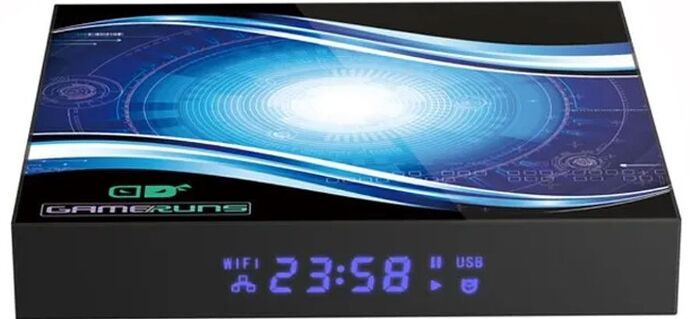Try it again with my original vfd, but change vfd_display_type='0x03,0x00,0x00,0x05' to vfd_display_type='0x01,0x00,0x00,0x05' (or vfd_display_type='0x00,0x00,0x00,0x05' if the numbers are upside down)
It works perfectly now with vfd_display_type=‘0x00,0x00,0x00,0x05’ and swapping “play” and “pause” in the dot bits line. I can’t check the wifi icon.
Thank you very much!!!
vontar-w2-atv-vfd.conf (1.2 KB)
Hopefully the next nightly will fix it, please let me know.
@lillypop I pushed the config to the github repo, thanks.
Same behavior as Wednesday. The USB icon is activated (only while the time is displayed) even if it is not connected. The rest of the icons are not activated, except for eth if I start playing something.
I made another fix, I think the logic should now work correctly. Will be in the next nightly.
Same behavior as yesterday. The USB icon is activated (only while the time is displayed) even if it is not connected. The rest of the icons are not activated, except for eth if I start playing something.
Are you sure that you’ve updated to the latest build? The behavior should have changed.
You are right, I’m sorry. By mistake, I had re-entered the build from day 8, instead of day 9. The only icon that doesn’t work now is the play/pause one. I also can’t test the wifi because it doesn’t work. Regarding this, can you help me understand why?
CoreELEC:~ # udevadm info /sys/bus/sdio/devices/* | paste
http://ix.io/4F0k
CoreELEC:~ # dmesg | paste
http://ix.io/4F0l
I leave you an image with all the icons that the VFD presents on Android, in case that helps.
The controller on your box is a FD650, it can only drive 4 digits + point (ie. icon in our case here)
According to your previous list, you should be able to see Wifi, Eth, USB and Colon.
If all of those work, that’s all that can be done.
In that case, the vfd is now perfect for uploading to the repository. The only thing I can’t test is the wifi, I would appreciate if you can take a look at the information provided in the previous post.
You mean wifi isn’t recognized? We have a thread for that.
I see that you’ve posted there already, sadly I’m not really familiar with the wifi thing.
The driver or firmware may be missing from our kernel, as vpeter said, may need to ask for driver/fw sources from the manufacturer.
@seias
I added the changes to the driver in order to support the new icon layout, it should be available in the next nightly build.
Here’s the new VFD conf file, it may require adjustments in vfd_dot_bits to light up the correct icons.
x96-x9-vfd.conf (1.2 KB)
Hi.
I own a Bqeel S1 Max S905x4 Box. It has a simple clock display with no other icons. After trying some vfd.conf files I found one that is working for my box, excerpt the digits are bottom to top. The file I’m using is “hk1-rbox-x4-vfd.conf”. Tried it as it also is a S905x4 box. I changed the last line from “vfd_display_type=‘0x00,0x00,0x00,0x06’” to “vfd_display_type=‘0x01,0x00,0x00,0x06’” and now the display (clock) is working correctly. Just in case someone else is using this box too.
As a new user I can’t upload the file here but it should be an easy task to modify it yourself.
Thanks for reading, Claus
Do you mean like this?
bqeel-s1-max-vfd.conf (1.2 KB)
Do all the icons light up correctly?
The box has no icons of any kind, even under Android there are no extra icons. So no way to lighten them up.
I see, in that case I’ll upload the vfd.conf, thanks.
Hello,
I came across a “Mutant Inferno SE” box with an Amlogic S905x3 on which I installed CoreELEC 20 (dtb: sm1_s905x3_2g). The display has indicators for power, LAN, WiFi high, WiFi low and clock with colon. When I start CE it permanently says “boot”. When Android starts, the display works as expected.
I have already tried various vfd configurations. Unfortunately without success. For now, it would be enough for me if the display is off, i.e. no longer constantly shows “boot”.
I also followed the description here as far as possible. But I can’t figure out how to make a vfd.conf out of it.
Output on Android:
$ cat /sys/kernel/debug/gpio
gpiochip1: GPIOs 410-495, parent: platform/pinctrl@ff634480, periphs-banks:
gpio-448 ( |amlsd ) out hi
gpio-458 ( |amlsd ) in lo
gpio-482 ( |sdio_wifi ) out hi
gpio-483 ( |sdio_wifi ) in hi
gpio-493 ( |bt_rfkill ) in lo
gpio-495 ( |bt_rfkill ) out hi
gpiochip0: GPIOs 496-511, parent: platform/pinctrl@ff800014, aobus-banks:
gpio-498 ( |avout_mute ) out hi
gpio-502 ( |stb_gpio ) out hi
gpio-503 ( |clock_gpio ) out hi
gpio-504 ( |data_gpio ) out hi
Output on CoreELEC:
$ cat /sys/kernel/debug/gpio
gpiochip1: GPIOs 410-495, parent: platform/pinctrl@ff634480, periphs-banks:
gpio-448 ( |amlsd ) out hi
gpio-458 ( |amlsd ) in lo
gpio-473 ( |openvfd ) in lo
gpio-474 ( |openvfd ) in hi
gpio-482 ( |sdio_wifi ) out hi
gpio-483 ( |sdio_wifi ) in hi
gpio-493 ( |bt_rfkill ) in lo
gpio-495 ( |bt_rfkill ) out hi
gpiochip0: GPIOs 496-511, parent: platform/pinctrl@ff800014, aobus-banks:
gpio-498 ( |avout_mute ) out hi
gpio-499 ( |key ) in hi
gpio-507 ( |? ) out lo
Try this config:
a95x-f2-aml-vfd.conf
yeehaw
It works - I had tried all possible configurations that showed that it was a S905x3 box.
Thanks a lot!
Your box may be S905X3, it’s just the pin layout and display type seem to match exactly the config of that A95X-F2 box.

